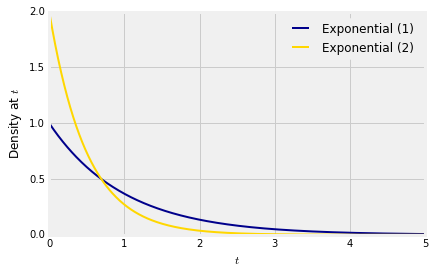Linear Transformations
Linear Transformations¶
Let $T$ have the exponential $(\lambda)$ distribution and let $T_1 = \lambda T$. Then $T_1$ is a linear transformation of $T$. Therefore
$$ E(T_1) = \lambda E(T) = 1 ~~~ \text{and} ~~~ SD(T_1) = \lambda SD(T) = 1 $$The parameter $\lambda$ has disappeared in these results. Let's see how that follows from the distribution of $T_1$. The cdf of $T_1$ is
$$ F_{T_1}(t) = P(T_1 \le t) = P(T \le t/\lambda) = 1 - e^{-\lambda (t/\lambda)} = 1 - e^{-t} $$That's the cdf of the exponential $(1)$ distribution, consistent with the expectation and SD we found above.
To summarize, if $T$ has the exponential $(\lambda)$ distribution then the distribution of $T_1 = \lambda T$ is exponential $(1)$.
You can think of the exponential $(1)$ distribution as the fundamental member of the family of exponential distributions. All others in the family can be found by changing the scale of measurement, that is, by multiplying by a constant.
Scale Parameter¶
Conversely if $T_1$ has the exponential $(1)$ distribution, then $T = \frac{1}{\lambda}T_1$ has the exponential $(\lambda)$ distribution. The factor $1/\lambda$ is called the scale parameter.
Here are graphs of the densities of $T_1$ and $T = \frac{1}{2}T_1$. We know that $T$ has the exponential $(2)$ distribution.
The formulas for the two densities are
$$ f_{T_1} (s) = e^{-s} ~~~~~~~~~~~~~~ f_T(t) = 2e^{-2t} $$Let's try to understand the relation between these two densities in a way that will help us generalize what we are seeing in this example.
The relation between the two random variables is $T = \frac{1}{2}T_1$.
- For any $t$, the chance that $T$ is near $t$ is the same as the chance that $T_1$ is near $s = 2t$. This explains the factor $e^{-2t}$ in the density of $T$.
- If we think of $T_1$ as a point on the horizontal axis, then to create $T$ you have to divide $T_1$ by 2. So the transformation consists of halving all distances on the horizontal axis. The total area under the density of $T$ must equal 1, so we have to compensate by doubling all distances on the vertical axis. This explains the factor 2 in the density of $T$.
Linear Change of Variable Formula for Densities¶
We use the same idea to find the density of a linear transformation of a random variable.
Let $X$ be a random variable with density $f_X$, and let $Y = aX + b$ for constants $a \ne 0$ and $b$. Let $f_Y$ be the density of $Y$. Then
$$ f_Y(y) ~ = ~ f_X\big{(} \frac{y-b}{a}\big{)} \frac{1}{\lvert a \rvert} $$Let's take this formula in two pieces, as in the exponential example.
- For $Y$ to be $y$, $X$ has to be $(y-b)/a$.
- The linear function $y = ax+b$ involves multiplying distances along the horizontal axis by $\lvert a \rvert$; the sign of $a$ doesn't affect distances. To get a density, we have to compensate by dividing all vertical distances by $\lvert a \rvert$.
This is a good way to understand the formula, and will help you understand the corresponding formula for non-linear transformations.
For a formal proof, start with the case $a > 0$. $$ F_Y(y) = P(aX+b \le y) = P\big{(}X \le \frac{y-b}{a}\big{)} = F_X\big{(}\frac{y-b}{a}\big{)} $$
By the chain rule of differentiation, $$ f_Y(y) = f_X\big{(}\frac{y-b}{a}\big{)} \cdot \frac{1}{a} $$
If $a < 0$ then division by $a$ causes the direction of the inequality to switch:
$$ F_Y(y) = P(aX+b \le y) = P\big{(}X \ge \frac{y-b}{a}\big{)} = 1 - F_X\big{(}\frac{y-b}{a}\big{)} $$Now the chain rule yields $$ f_Y(y) ~ = ~ -f_X\big{(}\frac{y-b}{a}\big{)} \cdot \frac{1}{a} ~ = ~ f_X\big{(}\frac{y-b}{a}\big{)} \cdot \frac{1}{\lvert a \rvert} $$
The Normal Densities¶
Let $Z$ have the standard normal density
$$ \phi(z) ~ = ~ \frac{1}{\sqrt{2\pi}} e^{-\frac{1}{2}z^2}, ~~~ -\infty < z < \infty $$Let $X = \sigma Z + \mu$ for constants $\mu$ and $\sigma$ with $\sigma > 0$. Then for any real number $x$, the density of $X$ is
\begin{align*} f_X(x) ~ &= ~ \phi\big{(} \frac{x-\mu}{\sigma} \big{)} \frac{1}{\sigma} \\ \\ &= ~ \frac{1}{\sqrt{2\pi}\sigma} e^{-\frac{1}{2} \big{(} \frac{x-\mu}{\sigma} \big{)}^2} \end{align*}Thus every normal random variable is a linear transformation of a standard normal variable.
The Uniform Densities, Revisited¶
Let the distribution of $U$ be uniform on $(0, 1)$ and for constants $b > a$ let $V = (b-a)U + a$. In an earlier section we saw that $V$ has the uniform distribution on $(a, b)$. But let's see what's involved in confirming that result using our new formula.
First it is a good idea to be clear about the possible values of $V$. Since the possible values of $U$ are in $(0, 1)$, the possible values of $V$ are in $(a, b)$.
At $v \in (a, b)$, the density of $V$ is $$ f_V(v) ~ = ~ f_U\big{(} \frac{v - a}{b-a} \big{)} \frac{1}{b-a} ~ = ~ 1 \cdot \frac{1}{b-a} ~ = ~ \frac{1}{b-a} $$
That's the uniform density on $(a, b)$.
